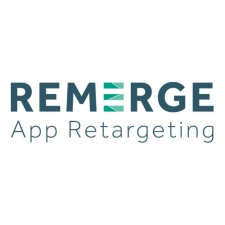Marta Gaspar is a senior content marketing manager APAC at Remerge.
In our previous piece, we touched upon the different reasons why you should run retargeting campaigns along with your UA. And retargeting is particularly relevant for gaming apps.
Competition continues to be one of the main challenges for mobile game developers, exacerbated by the sheer number of games being published out there. On one side, we see users growing interested in games; on the other hand, with more and more new games in the market, it gets harder and harder for games to turn their new users into engaged and paying players.
How to achieve this?
How to get from a big user base to a truly engaged and revenue-driven user base? Retargeting is the answer.
The latest data report from Appsflyer show that gaming apps will do well to increase their retargeting efforts in 2020. Retargeting campaigns are especially useful to keep users engaged and playing regularly and also incentivizing paying players to keep spending more and more often.
For the gaming industry, retaining users is critical and, knowing that it costs less to retarget a user than to acquire a new one, planning long-lasting retargeting campaigns is a sound investment.
In fact, according to Appsflyer data, the average revenue uplift among paying users who were exposed to a retargeting campaign was over 50% in gaming apps, more than double the industry average.

Where is the opportunity here?
Well, according to the same report, only 11% of gaming apps are putting their chips in retargeting. This is quite a low percentage in comparison to other verticals such as e-commerce, where 53% of apps already have retargeting strategies in place.
There is still a significant margin of gaming apps waiting to benefit from retargeting to stay relevant in the face of competition. Performance uplift is high for apps that put in the effort.
How does retargeting add value?
- Increased use retention
- Better engagement
- Improved conversions
A well planned retargeting strategy will ensure that your user base remains active and engaged throughout the game's lifetime. It is also an excellent tool to monetize your users at full capacity. Let's dive into how retargeting can aid your gaming app in the different stages of your game lifetime.
Retargeting and the game lifecycle: Launch, Growth, Peak and EndGame

Stage 1 - Launch
From a new game launch, user acquisition needs to be accompanied by a strong effort to increase engagement, to remind users to come back to the game after install. At this stage, the primary concern after acquiring a new user is to provide a good onboarding experience, educate, and to convert her to a paying user.
In this sense, a retargeting campaign can help achieve more retention, better user experience in the app by bringing a new user back to do a tutorial or start playing. It will make the game more relevant to players and consequently maximize user lifetime value (LTV).
A report by Adjust mentions that, for gaming, the average time between a user's last session and uninstall is three days; therefore, the time window to retain and convert is small. Waiting seven days of inactivity to initiate retargeting efforts is missing a big opportunity. A large proportion of users (~40%) who uninstall an app won't come back to redownload it.
If user retention is the foremost hurdle to overcome, running retargeting is instrumental in preventing churn after install and also providing valuable insights about your users early on. This useful data can be used to optimize the campaigns towards refining segmentation, maximizing ROI, and boosting retention.
Deploying retargeting at an early stage of a game lifecycle plays a fundamental role in your user monetization strategy to reach out to and motivate paying users for a new purchase.
Stages 2 and 3 - Game growth and peak
For the growth and peak stages, retargeting adds much value in many ways. First, it sustains your app by re-engaging users that haven't converted yet. It also can target high-value players to avoid drops on user activity and keep players engaged by exploring the entire game and purchasing more often.
Retargeting can help you increase your DAU (daily active users) by bringing back active users in good volumes at the lowest cost possible, by targeting specific users that exhibit a particular behavior or value.
As a specific example, a client running retargeting for a hardcore game had achieved very satisfactory results by retargeting a segment of their daily active users that are categorized as high value. Consistently re-engaging these big spenders early in their lifetime showed great benefits in improving their cohorted ROAS and retention rates.
At this growth stage, the focus is not only about scaling unique user numbers but, most importantly, to re-engage regular players and deepen their experience with the game before they lose interest. Retargeting assists in reaching these users whenever you want to inform them of any novelty and game areas they have not yet explored.
As a mobile marketer, it is vital to identify and retarget top users across different markets and segments, retarget them with specific messaging to find ways to sustain your app growth.
By identifying users that have completed certain levels or made their first in-app purchase, for example, it gets easier to target these specific segments with a different and more catered message. So, users who have just completed a transaction would see an ad with a special offer for future purchases.
At the same time, users who have completed a certain level will see an ad that references explicitly to aspects of that level (e.g., setting, character, or prize to be redeemed) and incentivizes them to continue.
Stage 4 - Established games
For mature titles, retargeting revives and can bring churned users back to the game. Once apps reach their peak in terms of reach and installs, it gets increasingly challenging to reduce user churn, and the focus shifts from growth to maintenance and efficiency. Informing users efficiently at scale about product updates would be key to extend LTV as much as possible.
At this stage, marketers will have gathered a good chunk of data that can provide deeper insights into the entire user base and their behaviors. Established games still have to put effort into their product, in terms of improving the game, introducing new mechanics or levels, for example. Retargeting can then help to reach users to get them to try those game novelties.
Critical at this stage is also to identify your "whales," your most high-value users, and retarget them. They are your loyal user base in which you can capitalize to keep your game active and profitable.
Recap
The biggest miss for gaming this year could be retargeting, as the games industry is yet to adopt retargeting as widely as it should. Considering that retargeting is shown to be a more affordable tool in the marketing arsenal than UA, there is an excellent opportunity for gaming apps that are ready to invest and implement retargeting strategies.
The purpose of retargeting for gaming is straightforward: to make users onboard seamlessly with a positive experience and hence maximize playing time as well as spend.
While the product quality is crucial and entirely in the hands of the developer, retargeting enhances the bandwidth significantly to communicate an awesome game experience, shorten "time to in-app revenue", and to secure a share of voice to the user community. For gaming apps looking into ramping up their retargeting efforts in 2020, the time is now.
App retargeting isn't a one-off tactic. Instead, it is an ongoing project that needs to be monitored and nurtured over time. The most successful campaigns are those who are continually evolving as a response to deep insights from performance data.
Measuring incremental growth and knowing the real value of retargeting is now a straightforward process with Remerge. Measuring uplift is done transparently based on accessible raw data to give marketers maximum insights and to optimize their investments further.
If you are an app marketer interested in understanding the real value of your campaigns and trying to make informed decisions about your retargeting strategy, reach out to us at hello@remerge.io.
Read more about mobile marketing and retargeting here:
- App Retargeting Strategies To Drive Revenue To Your Mobile Game
- Importance of Running Retargeting Along With UA
- More about retargeting adoption trends in The State of Gaming App Marketing: 2019 Insights report by AppsFlyer






















